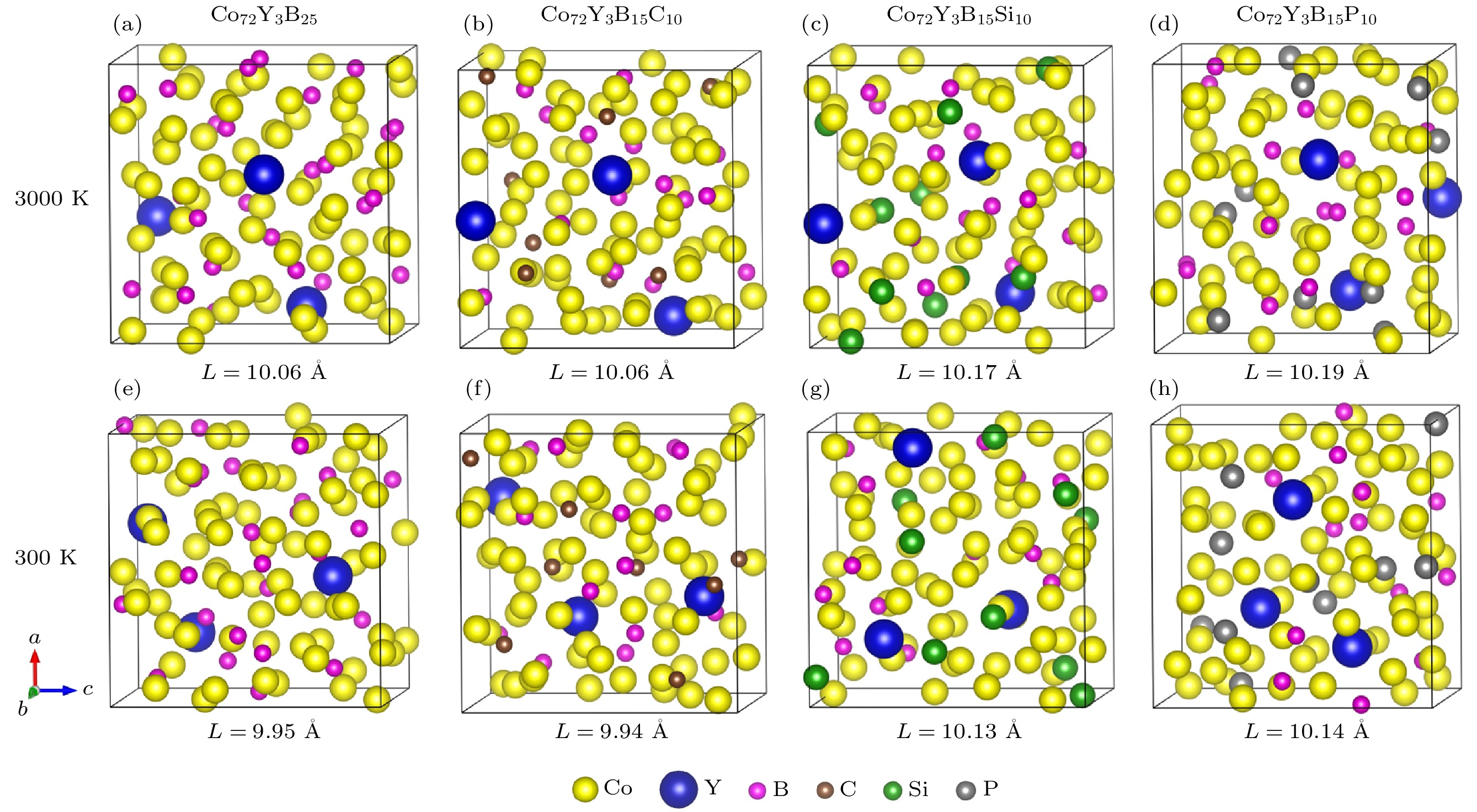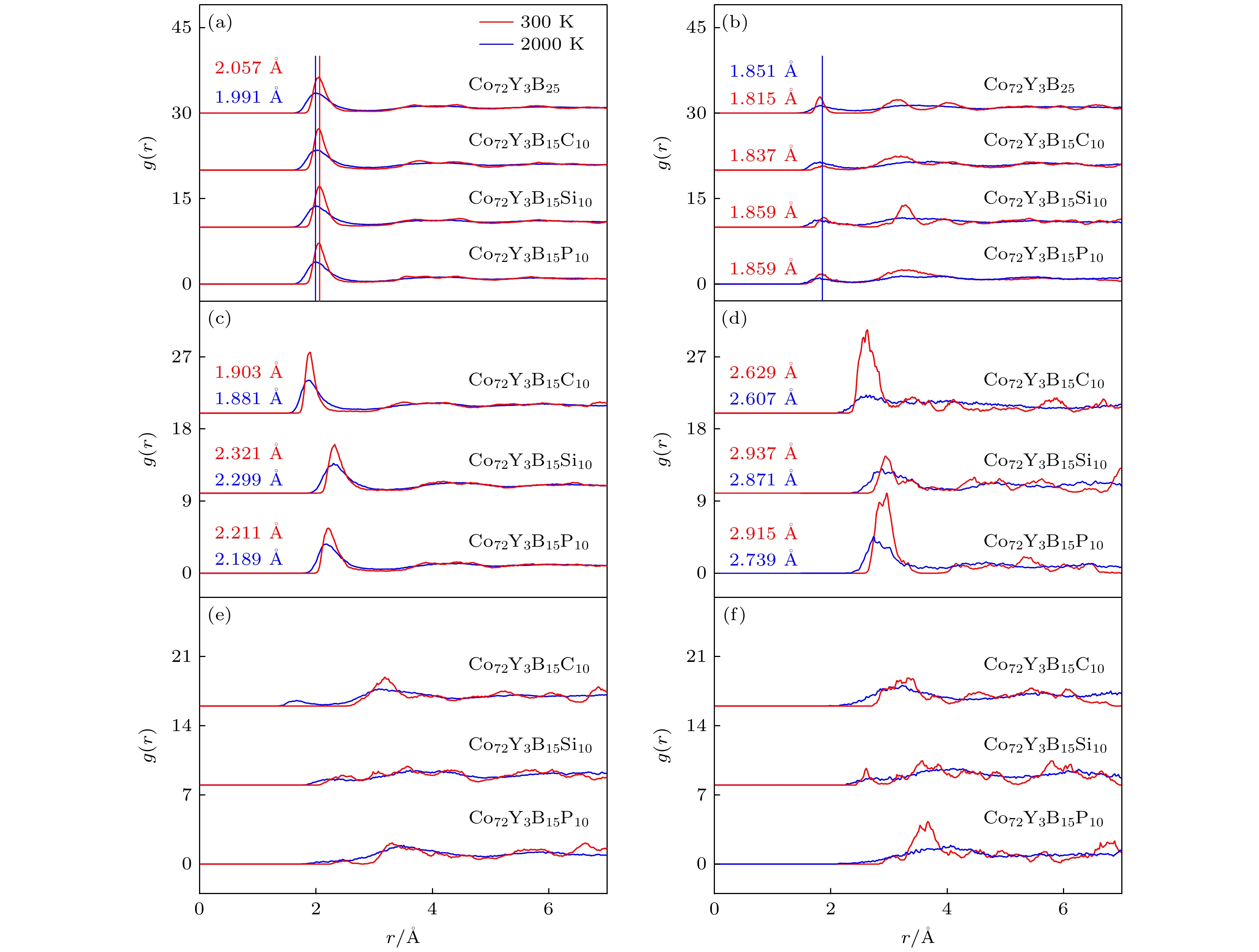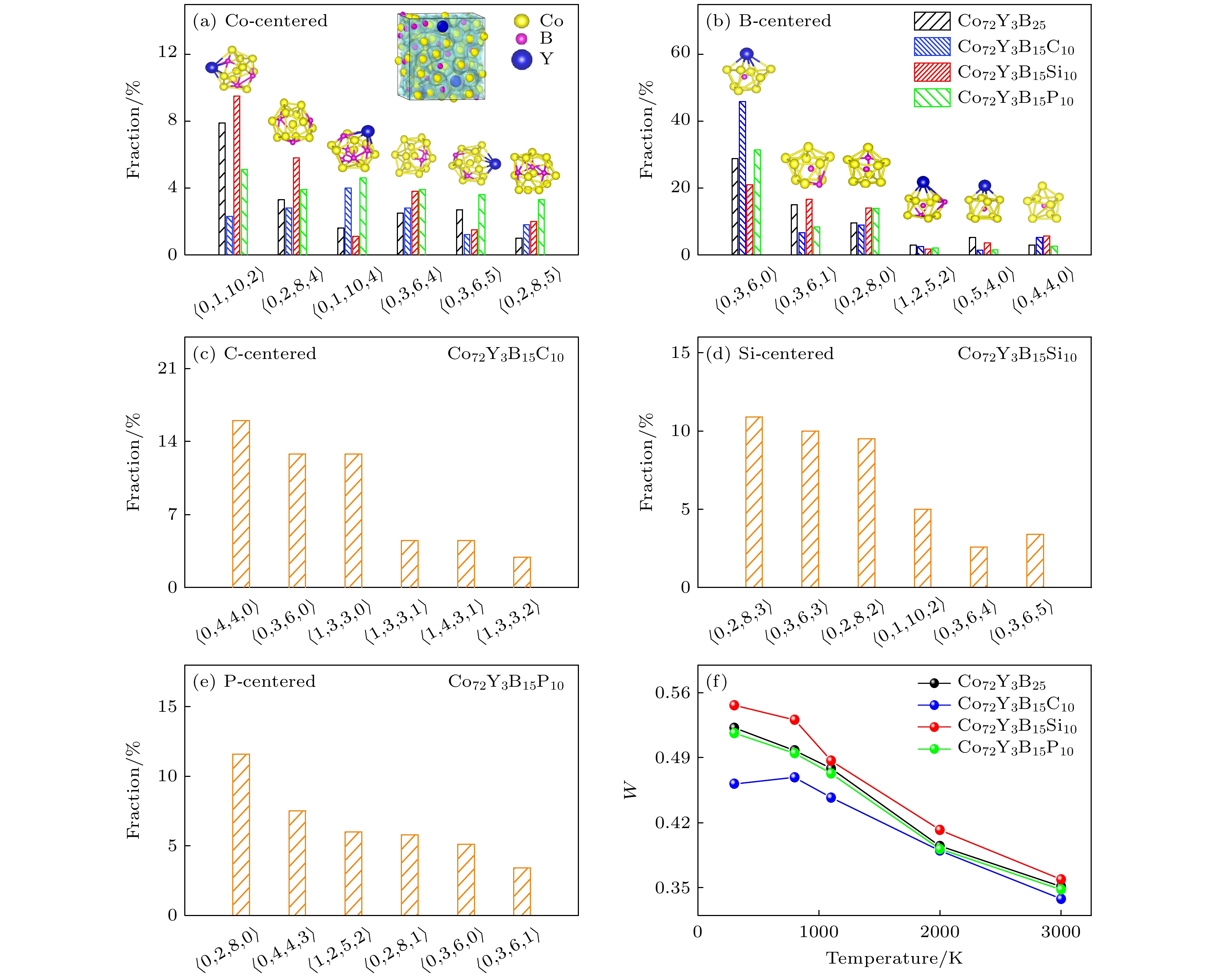-
本文采用第一性原理分子动力学(ab initio molecular dynamics, AIMD)方法模拟了Co72Y3B15M10 (M = B, C, Si, P) 合金形成非晶的过程, 探究添加类金属元素C, Si, P对Co基Co-Y-B合金非晶形成能力(glass-formingability, GFA)和磁性能的影响, 着重从原子层面分析了局域原子结构与性能的关联. 计算的局域原子结构表征参数有对分布函数、配位数、化学短程序、Voronoi多面体指数、局域五次对称性和均方位移. 结果表明, 4种合金不同的局域原子结构特征造成其GFA的差异. Co72Y3B15C10和Co72Y3B15P10合金中棱柱结构的含量较高, B/C-C和B/P-P原子间的溶质分离性较弱, 过冷态时(1100 K)原子扩散能力较强, 不利于提高合金的GFA. Co72Y3B15Si10合金中畸变二十面体结构的含量较高, Co-Si原子间吸引力较强, B/Si-Si原子间具有较好的分离性, 过冷态时原子的扩散能力较低, 有利于提高合金的GFA. 因此, 添加Si元素有助于提高合金的GFA, 而C和P元素的添加会降低GFA, 且C元素对GFA的削弱作用更为明显. 4种合金的GFA按Co72Y3B15Si10 > Co72Y3B25 > Co72Y3B15P10 > Co72Y3B15C10的顺序依次降低. 添加C, Si, P元素使体系的总磁矩均有所下降, 按照Co72Y3B25 > Co72Y3B15Si10 > Co72Y3B15C10 > Co72Y3B15P10的顺序依次递减. Co-Si原子间较强的p-d轨道杂化作用增强了磁交换耦合作用, 导致添加Si元素对总磁矩的削弱作用较小.
-
关键词:
- Co基非晶合金 /
- 第一性原理分子动力学模拟 /
- 非晶形成能力 /
- 磁性能
Co-based metallic glass (MG) is a new class of soft magnetic material and has promising applications in high-frequency fields due to its high magnetic permeability and low coercivity. However, this kind of MG has poor glass-formation ability (GFA) and relatively low saturated magnetic flux density, so its application scope is limited. The atomic size of metalloid element M (B, C, Si, and P) is small, which can easily enter into the gap between atoms, and there is a relatively large negative enthalpy of mixing between metalloid element and metal element. Therefore, alloying with metalloid element M is an effective method to improve the GFA while maintaining superior soft magnetic properties for Co-based MG. In this work, the formation process of Co72Y3B15M10 MG is simulated by ab initio molecular dynamics (AIMD) method, and the effects of the addition of metalloid elements C, Si, P on the GFA and magnetic properties of Co-Y-B MGs are investigated. It is devoted to analyzing the relationship between local atomic structure and property at an atomic level. According to the results of the characterization parameters of local atomic structure (pair distribution function, coordination numbers, chemical short-range order, Voronoi polyhedron index, local five-fold symmetry, and mean square displacement), it is found that the GFA of the four alloys is different due to their different local atomic structures. Both Co72Y3B15C10 alloy and Co72Y3B15P10 alloy possess a higher fraction of prism structure, weaker solute segregation between B/C-C and B/P-P atoms, higher atomic diffusivity in the supercooled state (1100 K), and hence weakening the GFA of the alloys. The Co72Y3B15Si10 alloy has a higher fraction of icosahedral-like structure, stronger attraction between Co-Si atoms and the solute segregation between B/Si-Si atoms, lower atomic diffusivity in the supercooled state, thereby increasing the GFA. Therefore, the addition of Si is beneficial for enhancing the GFA, while the addition of C or P will reduce the GFA, that is, the GFA of the four alloys decreases in the order of Co72Y3B15Si10 > Co72Y3B25 > Co72Y3B15P10 > Co72Y3B15C10. In terms of magnetic properties, with the addition of C, Si, P elements, the total magnetic moment of Co72Y3B15M10 (M = B, C, Si, P) alloy decreases in the following order: Co72Y3B25 > Co72Y3B15Si10 > Co72Y3B15C10 > Co72Y3B15P10. The stronger p-d orbital hybridization between Co-Si atoms enhances the ferromagnetic exchange interaction, leading the total magnetic moment to be less affected by Si addition. -
Keywords:
- Co-based metallic glasses /
- ab initio molecular dynamics simulations /
- glass-forming ability /
- magnetic property
[1] Wang W H, Dong C, Shek C H 2004 Mater. Sci. Eng. R 44 45
 Google Scholar
Google Scholar
[2] Inoue A, Shen B L, Koshiba H, Kato H, Yavari A R 2003 Nat. Mater. 2 661
 Google Scholar
Google Scholar
[3] Wang Q Q, Zhang G L, Zhou J, Yuan C C, Shen B L 2020 J. Alloys Compd. 820 153105
 Google Scholar
Google Scholar
[4] Taghvaei A H, Stoica M, Prashanth K G, Eckert J 2013 Acta Mater. 61 6609
 Google Scholar
Google Scholar
[5] Wang W H 2007 Prog. Mater. Sci. 52 540
 Google Scholar
Google Scholar
[6] Lu Z P, Liu C T 2004 J. Mater. Sci. 39 3965
 Google Scholar
Google Scholar
[7] Zhao Y M, Li X, Liu X B, Bi J Z, Wu Y, Xiao R J, Li R, Zhang T J 2021 Mater. Sci. Technol. 86 110
 Google Scholar
Google Scholar
[8] Pang S J, Zhang T, Asami K, Inoue A 2002 Acta Mater. 50 489
 Google Scholar
Google Scholar
[9] Shen B L, Inoue A 2002 Mater. Trans. 43 1235
 Google Scholar
Google Scholar
[10] Jiang J W, Li Q, Duan H M, Li H X 2017 Comput. Mater. Sci 130 76
 Google Scholar
Google Scholar
[11] Zhang W, Li Q, Duan H M 2015 J. Appl. Phys 117 104901
 Google Scholar
Google Scholar
[12] Hibino T, Bitoh T 2017 J. Alloys Compd. 707 82
 Google Scholar
Google Scholar
[13] Wang A D, Zhao C L, He A N, Men H, Chang C T, Wang X M 2016 J. Alloys Compd. 656 729
 Google Scholar
Google Scholar
[14] Guo G Q, Yang L, Wu S Y, Zeng Q S, Sun C J, Wang Y G 2016 Mater. Des. 103 308
 Google Scholar
Google Scholar
[15] Ran Y Z, Li Y H, Ma S, Lai L Q, Chen J, Wang X D, Jiang L, Yao M, Zhang W 2022 J. Alloys Compd. 899 163326
 Google Scholar
Google Scholar
[16] Yu Q, Wang X D, Lou H B, Cao Q P, Jiang J Z 2016 Acta Mater. 102 116
 Google Scholar
Google Scholar
[17] Guan P F, Fujita T, Hirata A, Liu Y H, Chen M W 2012 Phys. Rev. Lett. 108 175501
 Google Scholar
Google Scholar
[18] Chen H, Zhou S X, Dong B S, Jin J J, Liu T Q, Guan P F 2020 J. Alloys Compd. 819 153062
 Google Scholar
Google Scholar
[19] Liang X Y, Li Y H, Bao F, Zhu Z W, Zhang H F, Zhang W 2021 Intermetallics 132 107135
 Google Scholar
Google Scholar
[20] Kohn W, Sham L J 1965 Phys. Rev. 140 1133
 Google Scholar
Google Scholar
[21] Blöchl P E 1994 Phys. Rev. B 50 17953
 Google Scholar
Google Scholar
[22] Kresse G, Hanfner J 1993 Phys. Rev. B 47 558
 Google Scholar
Google Scholar
[23] Wang Y, Perdew J P 1991 Phys. Rev. B 44 13298
 Google Scholar
Google Scholar
[24] Hoover W G 1985 Phys. Rev. A 31 1695
 Google Scholar
Google Scholar
[25] Nosé S 1984 J. Chem. Phys. 81 511
 Google Scholar
Google Scholar
[26] Spreiter Q, Walter M 1999 J. Comput. Phys. 152 102
 Google Scholar
Google Scholar
[27] Hamidreza H, Rossitza P 2018 ACS Catal. 8 11773
 Google Scholar
Google Scholar
[28] Cheng Y Q, Ma E 2011 Prog. Mater. Sci. 56 379
 Google Scholar
Google Scholar
[29] Cowley J M 1950 J. Appl. Phys. 21 24
 Google Scholar
Google Scholar
[30] Finney J L 1977 Nature 266 309
 Google Scholar
Google Scholar
[31] Hu Y C, Li F X, Li M Z, Bai H Y, Wang W H 2015 Nat. Commun. 6 8310
 Google Scholar
Google Scholar
[32] Zhao Y F, Lin D Y, Chen X H, Liu Z K, Hui X D 2014 Acta Mater. 67 266
 Google Scholar
Google Scholar
[33] Pont M, Puzniak R, Rao K V 1992 J. Appl. Phys. 71 5585
 Google Scholar
Google Scholar
[34] Wang Q, Zhai B, Wang H P, Wei B 2021 J. Appl. Phys. 130 185103
 Google Scholar
Google Scholar
[35] Hirata A, Hirotsu Y, Ohkubo T, Hanada T, Bengus V Z 2006 Phys. Rev. B 74 214206
 Google Scholar
Google Scholar
[36] Pang H, Jin Z H, Lu K 2003 Phys. Rev. B 67 094113
 Google Scholar
Google Scholar
[37] Williams A R, Moruzzi V L, Malozemoff A P, Terakura K 1983 IEEE Trans. Magn. 19 1983
 Google Scholar
Google Scholar
[38] Yuan C C, Yang F, Xi X K, Shi C L, Moritz H D, Li M Z, Hu F, Shen B L, Wang X L, Meyer A, Wang W H 2020 Mater. Today 32 26
 Google Scholar
Google Scholar
-
图 4 (a)—(e) 300 K时Co72Y3B15M10合金中以Co, B, C, Si, P原子为中心的主要Voronoi多面体含量, (f) 4种合金的LFFS参数W随温度的变化趋势
Fig. 4. (a)–(e) Fractions of major Voronoi polyhedral centered by Co, B, C, Si, and P atoms in Co72Y3B15M10 alloys at 300 K; (f) temperature dependence of LFFS parameters W during cooling for all of the alloys.
图 6 (a) Co72Y3B25, (b) Co72Y3B15C10, (c) Co72Y3B15Si10, (d) Co72Y3B15P10合金的总电子态密度和分波态密度, (e) 4种合金在费米能级附近的总电子态密度
Fig. 6. The total density of state (DOS) and partial DOS for (a) Co72Y3B25, (b) Co72Y3B15C10, (c) Co72Y3B15Si10, (d) Co72Y3B15P10 alloys, and (e) TDOSs for all of the alloys near the Fermi level.
表 1 Co72Y3B15M10合金的总磁矩和各元素的磁矩(单位: μB)
Table 1. The total magnetic moments of Co72Y3B15M10 alloys and the local magnetic moments for different elements (unit: μB).
Alloys μtotal μCo μY μB μC μSi μP Co72Y3B25 75.179 1.086 –0.133 –0.063 — — — Co72Y3B15C10 69.645 1.005 –0.097 –0.067 –0.042 — — Co72Y3B15Si10 72.722 1.053 –0.140 –0.059 — –0.037 — Co72Y3B15P10 68.969 0.977 –0.097 –0.057 — — –0.023 -
[1] Wang W H, Dong C, Shek C H 2004 Mater. Sci. Eng. R 44 45
 Google Scholar
Google Scholar
[2] Inoue A, Shen B L, Koshiba H, Kato H, Yavari A R 2003 Nat. Mater. 2 661
 Google Scholar
Google Scholar
[3] Wang Q Q, Zhang G L, Zhou J, Yuan C C, Shen B L 2020 J. Alloys Compd. 820 153105
 Google Scholar
Google Scholar
[4] Taghvaei A H, Stoica M, Prashanth K G, Eckert J 2013 Acta Mater. 61 6609
 Google Scholar
Google Scholar
[5] Wang W H 2007 Prog. Mater. Sci. 52 540
 Google Scholar
Google Scholar
[6] Lu Z P, Liu C T 2004 J. Mater. Sci. 39 3965
 Google Scholar
Google Scholar
[7] Zhao Y M, Li X, Liu X B, Bi J Z, Wu Y, Xiao R J, Li R, Zhang T J 2021 Mater. Sci. Technol. 86 110
 Google Scholar
Google Scholar
[8] Pang S J, Zhang T, Asami K, Inoue A 2002 Acta Mater. 50 489
 Google Scholar
Google Scholar
[9] Shen B L, Inoue A 2002 Mater. Trans. 43 1235
 Google Scholar
Google Scholar
[10] Jiang J W, Li Q, Duan H M, Li H X 2017 Comput. Mater. Sci 130 76
 Google Scholar
Google Scholar
[11] Zhang W, Li Q, Duan H M 2015 J. Appl. Phys 117 104901
 Google Scholar
Google Scholar
[12] Hibino T, Bitoh T 2017 J. Alloys Compd. 707 82
 Google Scholar
Google Scholar
[13] Wang A D, Zhao C L, He A N, Men H, Chang C T, Wang X M 2016 J. Alloys Compd. 656 729
 Google Scholar
Google Scholar
[14] Guo G Q, Yang L, Wu S Y, Zeng Q S, Sun C J, Wang Y G 2016 Mater. Des. 103 308
 Google Scholar
Google Scholar
[15] Ran Y Z, Li Y H, Ma S, Lai L Q, Chen J, Wang X D, Jiang L, Yao M, Zhang W 2022 J. Alloys Compd. 899 163326
 Google Scholar
Google Scholar
[16] Yu Q, Wang X D, Lou H B, Cao Q P, Jiang J Z 2016 Acta Mater. 102 116
 Google Scholar
Google Scholar
[17] Guan P F, Fujita T, Hirata A, Liu Y H, Chen M W 2012 Phys. Rev. Lett. 108 175501
 Google Scholar
Google Scholar
[18] Chen H, Zhou S X, Dong B S, Jin J J, Liu T Q, Guan P F 2020 J. Alloys Compd. 819 153062
 Google Scholar
Google Scholar
[19] Liang X Y, Li Y H, Bao F, Zhu Z W, Zhang H F, Zhang W 2021 Intermetallics 132 107135
 Google Scholar
Google Scholar
[20] Kohn W, Sham L J 1965 Phys. Rev. 140 1133
 Google Scholar
Google Scholar
[21] Blöchl P E 1994 Phys. Rev. B 50 17953
 Google Scholar
Google Scholar
[22] Kresse G, Hanfner J 1993 Phys. Rev. B 47 558
 Google Scholar
Google Scholar
[23] Wang Y, Perdew J P 1991 Phys. Rev. B 44 13298
 Google Scholar
Google Scholar
[24] Hoover W G 1985 Phys. Rev. A 31 1695
 Google Scholar
Google Scholar
[25] Nosé S 1984 J. Chem. Phys. 81 511
 Google Scholar
Google Scholar
[26] Spreiter Q, Walter M 1999 J. Comput. Phys. 152 102
 Google Scholar
Google Scholar
[27] Hamidreza H, Rossitza P 2018 ACS Catal. 8 11773
 Google Scholar
Google Scholar
[28] Cheng Y Q, Ma E 2011 Prog. Mater. Sci. 56 379
 Google Scholar
Google Scholar
[29] Cowley J M 1950 J. Appl. Phys. 21 24
 Google Scholar
Google Scholar
[30] Finney J L 1977 Nature 266 309
 Google Scholar
Google Scholar
[31] Hu Y C, Li F X, Li M Z, Bai H Y, Wang W H 2015 Nat. Commun. 6 8310
 Google Scholar
Google Scholar
[32] Zhao Y F, Lin D Y, Chen X H, Liu Z K, Hui X D 2014 Acta Mater. 67 266
 Google Scholar
Google Scholar
[33] Pont M, Puzniak R, Rao K V 1992 J. Appl. Phys. 71 5585
 Google Scholar
Google Scholar
[34] Wang Q, Zhai B, Wang H P, Wei B 2021 J. Appl. Phys. 130 185103
 Google Scholar
Google Scholar
[35] Hirata A, Hirotsu Y, Ohkubo T, Hanada T, Bengus V Z 2006 Phys. Rev. B 74 214206
 Google Scholar
Google Scholar
[36] Pang H, Jin Z H, Lu K 2003 Phys. Rev. B 67 094113
 Google Scholar
Google Scholar
[37] Williams A R, Moruzzi V L, Malozemoff A P, Terakura K 1983 IEEE Trans. Magn. 19 1983
 Google Scholar
Google Scholar
[38] Yuan C C, Yang F, Xi X K, Shi C L, Moritz H D, Li M Z, Hu F, Shen B L, Wang X L, Meyer A, Wang W H 2020 Mater. Today 32 26
 Google Scholar
Google Scholar
计量
- 文章访问数: 5337
- PDF下载量: 84
- 被引次数: 0














 下载:
下载:





